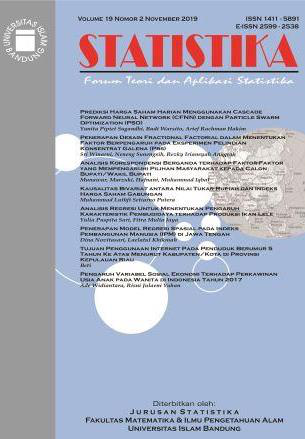Pemodelan Kurva Engel Non Makanan dengan Bayesian Quantile Regression di Provinsi Papua
DOI:
https://doi.org/10.29313/statistika.v22i1.335Keywords:
Engel, Non Makanan, Bayesian, Kuantil, PapuaAbstract
ABSTRAK
Tujuan paper ini adalah untuk melakukan pemodelan kurva Engel non makanan, dimana pada sebaran data mengindikasikan terjadinya heterokedastisitas. Metode yang digunakan dalam penelitian ini adalah regresi kuantil dengan pendekatan Bayesian. Sumber data yang digunakan adalah data pengeluaran konsumsi rumah tangga dan pengeluaran konsumsi rumah tangga untuk non makanan di Provinsi Papua, yang berasal dari SUSENAS Maret 2018. SUSENAS adalah salah satu survei yang dilaksanakan Badan Pusat Statistik. Rumah tangga sampel SUSENAS Maret 2018 sebanyak 10629 rumah tangga. Hasil dari penelitian ini adalah regresi kuantil Bayesian jauh lebih representatif karena mencakup sebaran data, baik pada sentral data maupun daerah disekitar sentral data, dibandingkan regresi linear biasa, dimana regresi linear biasa hanya mencakup berkisar pada sentral data. Ini berimplikasi bahwa pemodelan kurva Engel dengan regresi kuantil adalah sangat cocok dengan sebaran data. Pengeluaran konsumsi rumah tangga berpengaruh positif dan signifikan pada pengeluran konsumsi rumah tangga untuk non makanan. Proporsi pengeluaran konsumsi rumah tangga untuk non makanan berbeda-beda untuk setiap tingkat pengeluarannya. Semakin tinggi pengeluaran rumah tangga, maka proporsi konsumsi untuk non makanan, semakin besar proporsinya. Dan sebaliknya, rumah tangga dengan level pengeluaran rendah, Proporsi konsumsi untuk makan dan minum lebih besar daripada konsumsi untuk non makanan.
ABSTRACT
This paper aims to model a non-food Engel curve, where the distribution of data shows heteroscedasticity. The method used in this research is quantile regression with the Bayesian approach. The data sources used are household consumption expenditure data and household nonfood consumption expenditures in Papua Province which are derived from SUSENAS March 2018. SUSENAS is one of the surveys conducted by the Badan Pusat Statistik-Statistics Indonesia. SUSENAS March 2018 sample households were 10629 households. The result of this study is that Bayesian quantile regression is much more representative covering the distribution of data, both in the data center and around it, compared to ordinary linear regression, where ordinary linear regression only has a wide range because of the central data. This implies that the modeling of the Engel curve with quantile regression is very suitable for the distribution of the data. Household consumption expenditure has a positive and significant effect on non-food household consumption expenditure. The proportion of household consumption expenditure on food varies for each level of competition. The higher the household expenditure, the higher the proportion of non-food consumption. And conversely, in households with low levels of expenditure, the proportion of consumption for food is greater than consumption for non-food.
References
Chai, A. & A. Moneta, A. (2010). Retrospectives: Engel curves. Journal of Economic Perspectives, 24(1), 225–240.
Choi, H.M. & and J.P. Hobert, J.P. (2013). Analysis of MCMC algorithms for Bayesian linear regression with Laplace errors. Journal of Multivariate Analysis, 117, 32–40.
Koenker, R & Bassett, G. (1978). Regression quantiles. Econometrica, 46(1), 33–50.
Kozumi, H. & Kobayashi, G. (2011). Gibbs Sampling methods for Bayesian quantile regression. Journal of Statistical Computation and Simulation, 81(11), 1565–1578.
Kruschke, J.K. (2010). Doing Bayesian Data Analysis: A Tutorial with R and BUGS. Academic Press/Elsevier.
Leser, C.E.V. (1963). Form of Engel functions. Econometrica, 31(4), 694-703.
Lewbel, A. (2007). Engel Curves. The New Palgrave Dictionary of Economics. https://www2.bc.edu/arthur-lewbel/palengel.pdf
Tilak, T.B.G. (2000). Education poverty in India. NIEPA Occasional Paper 29.
Timmer, C.P., Falcon, W.P. dan Pearson, S. R. (1983). Food policy Analysis. Baltimore: Johns Hopkins University Press.
Tsionas, E.G. (2003). Bayesian quantile inference. Journal of Statistical Computation and Simulation,73(9), 659–674.
Yu, K. & R.A. Moyeed, R.A. (2001). Bayesian quantile regression. Statistics & Probability Letters, 54, 437–447.
















